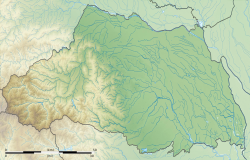You can help expand this article with text translated from the corresponding article in Japanese. (March 2024) Click [show] for important translation instructions.
|
| Kawagoe Castle 川越城 | |
|---|---|
| Kawagoe, Saitama, Japan | |
 | |
| Coordinates | 35°55′28″N 139°29′29″E / 35.924514°N 139.491503°E |
| Type | Japanese castle |
| Site information | |
| Controlled by | Kawagoe clan, Hōjō clan, Uesugi clan |
| Condition | Dismantled, relocated. Some buildings remain on or near the original site. |
| Site history | |
| Built | 1457 |
| Built by | Ōta Dōshin, Ōta Dōkan |
| In use | 1457 – c.1870 |
| Demolished | 1870 |
| Battles/wars | Battle of Kawagoe (1545)-(1546) |
Kawagoe Castle (川越城, Kawagoe-jō) is a flatland Japanese castle in the city of Kawagoe, in Japan's Saitama Prefecture. It is the closest castle to Tokyo to be accessible to visitors, as Edo castle is now the Imperial palace, and largely inaccessible.
Along with a number of other castles in the region, Kawagoe saw much action in the 15th-16th centuries, as the Later Hōjō clan and two branches of the Uesugi clan vied for control of the Kantō region. In the 1450s, Kawagoe was held by the Yamanouchi branch of the Uesugi; the Ogigayatsu branch controlled nearby Shirai castle in Shimōsa Province, and the newly built Edo castle, which significantly bolstered their tactical advantages over their Yamanouchi cousins.
Decades later, when the Hōjō clan sought to gain control of the Kantō, Hōjō Ujitsuna took Edo castle in 1524, and subsequently seized Kawagoe in 1537, with the latter serving as an important base of operations. For roughly two decades after that, the Uesugi launched a number of attempts to regain the region. This culminated in the 1545 Siege of Kawagoe Castle, as the heavily outnumbered Hōjō garrison of Kawagoe defeated an attempted siege of Edo castle. This victory would lead to the end of Uesugi power in the region, and the near-total destruction of that clan.
The Hōjō having secured themselves in the region, Kawagoe served for another forty-five years as a satellite fortress defending Edo, and the clan's central castle at Odawara. Kawagoe commanded the road to Echigo province to the west, and its location on the Arakawa River and near the Edo River were important elements of its tactical significance in defending the Kantō from attacks from the north.
From the fall of the Later Hōjō until the end of the Edo period, it was the headquarters of the Kawagoe Domain.

